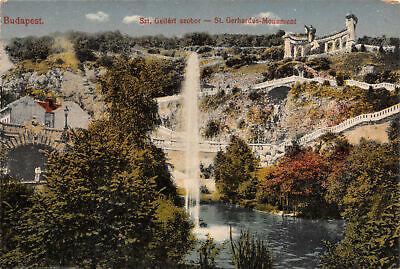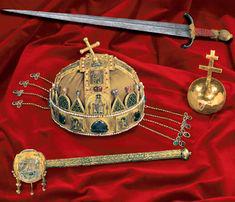Hungary is a country in Central Europe. It borders Slovakia to the north, Ukraine to the northeast, Romania to the east and southeast, Serbia to the south, Croatia and Slovenia to the southwest, and Austria to the west. Hungary covers an area of 93,030 square kilometers (35,920 sq mi) in the Carpathian Basin, with a population of 9,730,000. Hungarian, the official language, is the world's most widely spoken Uralic language, and among the few non-Indo-European languages widely spoken in Europe. Budapest is the country's capital and largest city; other major urban areas include Debrecen, Szeged, Miskolc, Pécs, and Győr. Religions: 54.3% Christianity (39.0% Catholicism, 11.8% Protestantism, 3.5% other Christians), etc.
Relations to Poland, Kiew
The first Christian king of Hungary, Saint István, had sent his three princely sons, Vazul, Endre, Levente and Béla, to Poland; specifically for diplomatic, networking purposes, in order to develop and practice Hungarian royal diplomacy in the 11th century. In Poland, the three princes vanished from public view and led their lives incognito for a time. Later, Prince Endre and Prince Levente went to Kiew while Béla stayed in Cracow and joined the Polish army of King Miesco II (990-1034), where his identity was revealed in a dramatic episode. He later secured victory for the Polish army against the Pomeranians (German); King Miesco invited Prince Béla to his court and gave him his daughter Richesa (1013-1075) in marriage. She gave birth to four daughters and three sons: Géza, László and Lambert.
Historical Intermezzo: Pagan Uprising
In Hungary, a chief named Vata led the rebels, the anti-Christian, anti-royal groups who were all pagans. These groups proclaimed that the country’s downfall was caused by the introduction of a foreign tongue (Latin) and foreign customs (German), and the rejection of the ancient faith. A violent hatred for foreigners arose, and in their fury, the masses turned against all strangers and Christian priests.
Martyrdom of Bishop Gellért
Among the victims of their rage was the respected and saintly Bishop Gerard (Saint Gellért, 977-1046), who suffered his martyrdom in a peculiar way. He was captured by pagan rebels in Buda, and dragged to the top of a steep, rocky hill beside the Danube called Kelen-hegy. There, the rebels put him in a barrel hammered through with spikes, nailed the lid shut, and set the barrel plunging from the steep hill. Bishop Gellért (Gerard) was later canonized and Kelenhegy was renamed Saint Gellért Hill. A statue erected close to the bottom of the hill near the Danube reminds visitors to Budapest of his Martyrdom (29th August 1046).
New King Endre I and his complicated struggle for Christianity
The eldest of the princely brothers, Endre I (also called András, lived 1015-1060, ruled 1046-1060), was the most eligible for the Hungarian throne. By this time married to the daughter of the Grand Prince of Kiew, Endre brought in troops from Kiew. Their combined forces defeated King Peter’s German army at Székesfehérvár in 1041. King Peter himself was captured and in a biblical retribution for Vazul’s fate (an eye for an eye...), he was first blinded and then executed.
The new King Endre I found himself in a precarious position. He owed his throne to Vata’s pagan forces, yet he considered himself a Christian and wanted to continue Saint István’s policy of forcing the country to adopt the Christian faith. Therefore, he did not persecute those who professed to be pagan. King Endre I knew that the best policy toward paganism was to let it fade away. And fade away it did, because Vata’s rebellion was the last serious flare-up of pagan sentiments in Hungary.
Crown or Sword?
To reassert German supremacy, King Henry III (1017-1056) sent a large army against Hungary early in Endre’s reign. Following the return (from Poland to Hungary) of the third brother (Prince Béla), King Endre I promptly appointed him chief of the Hungarian army; and with this title, Béla gained authority over a third of the country. The new chief set out with his troops to meet the Germans, led by Henry III himself, with his fleet positioned at Pozsony (now called Bratislava, Slovakia) on the Danube. Béla had no ships but compensated for his lack with ingenuity.
Prince Béla introduced underwater warfare by sending divers into the river under cover of night to scuttle the German ships. To Henry’s consternation, sunrise found his once proud German fleet resting at the bottom of the river. The celebrated hero of this undertaking was a man named Kund (Zotmund), whose exploit is narrated in a poem titled ‘Búvár Kund’ (Kund the Diver) by the famous poet and dramatist of the 19th-century reformation era, Mihály Vörösmarty (1800-1855).
As has already been said, Prince Béla had fathered three sons, Géza, László and Lambert, while King Endre I only had a five-year-old boy, Salamon. Nevertheless, Endre wanted his young Salamon to be his heir rather than the oldest able-bodied man in the House of Árpád, in this case Béla. A potentially fatal meeting between Endre I and Prince Béla dramatized the situation.
As narrated by contemporary chronicles, King Endre I invited Béla to his new castle in Várkony, where he kept Saint István’s crown as well as the other coronation regalia. When Béla arrived, he was received with great honor, then led into a room where on a table draped in red velvet lay the crown - and a sword.
King Endre I, calling his brother to the table, asked:
- Which do you want? The crown or the sword?
To everyone’s surprise, Prince Béla, the rightful successor to the throne according to ancient tradition, pointed to the sword and said:
- It was with the sword that I won my wife, my family and my glory. If necessary, I could obtain the crown and country by the sword. But your fatherly heart should stop worrying: the crown shall belong to your son.
Choosing the sword at that dramatic encounter may well have saved Béla’s life. Had he chosen the crown, he would have been killed on the spot by the king’s henchmen who were hiding behind the curtains. The chronicles suggest that Prince Béla had been alerted to the danger before he entered the room by a friend who whispered into his ear: “Choose the sword!”.
As King Endre I died, Prince Béla gave him a royal burial, and then assumed the crown which was rightfully his. How many years he had waited, how many battles he had fought, how many laurels he had earned on the long road which finally led him to the Hungarian throne! The nation welcomed his short rule (1060-1063) with expectations of a glorious era.
(Historical collection on which the article is based: S. Sisa, The Spirit of Hungary, Ontario, 1984)
To be continued…













